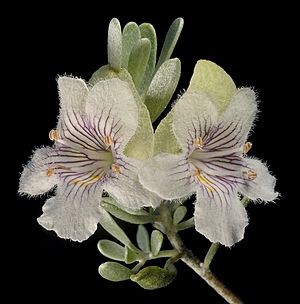Prostanthera althoferi facts for kids
Quick facts for kids Prostanthera althoferi |
|
|---|---|
 |
|
| Scientific classification | |
| Genus: |
Prostanthera
|
| Species: |
althoferi
|
 |
|
| Occurrence data from AVH | |
Prostanthera althoferi is a special kind of flowering plant, often called a mintbush, that belongs to the Lamiaceae family. This plant is only found in the inland parts of Australia, which means it's endemic there. It grows as an upright bush, and its stems and leaves are covered in soft, silvery-grey-green hairs. Its leaves are narrow and egg-shaped, and its flowers are white or cream-coloured with pretty mauve or purple stripes inside.
Contents
What Does Prostanthera althoferi Look Like?
Prostanthera althoferi is an upright shrub that usually grows to be about 0.5 to 3 meters tall. Its stems are square-shaped and covered thickly with silvery, grey-green hairs.
The leaves of this plant are attached directly to the stem without a stalk. They are narrow and shaped like an egg, with the narrower part at the base. These leaves are also covered in silvery-grey-green hairs and are usually 7 to 36 mm long and 1 to 2.5 mm wide.
The flowers grow one by one in the leaf corners near the ends of the branches. Each flower sits on a short, hairy stalk that is about 0.9 to 3.3 mm long.
The green to cream-coloured sepals, which are like small leaves protecting the flower bud, form a hairy tube. This tube is 1.8 to 4 mm long and often has a maroon tint. It has two main parts, called lobes. The lower lobe is broadly egg-shaped, about 2 to 3 mm long and 2 to 4 mm wide. The upper lobe is a bit longer, 3.5 to 5.5 mm long and 2.5 to 6.5 mm wide.
The petals of the flower form a tube that is 6.5 to 9 mm long. These petals are white to cream-coloured and have lovely mauve to purple stripes inside. The lower part of the flower has three lobes. The middle lobe is shaped like a spatula, 3.5 to 6.5 mm long and 2.5 to 5.5 mm wide. The two side lobes are 2.2 to 5 mm long and 1.5 to 3.5 mm wide. The upper part of the flower has two lobes, which are 2.6 to 5 mm long and about 3 to 7.5 mm wide.
You can usually see this plant flowering from March to October.
How This Plant Got Its Name
The plant Prostanthera althoferi was first officially described in 1988. This was done by a scientist named Barry Conn. He wrote about it in a science journal called Nuytsia. The plants he studied were collected near a place called Leonora in 1975.
The second part of the plant's scientific name, althoferi, was chosen to honor George Althofer.
In the same journal, Barry Conn also described two different types, or subspecies, of Prostanthera althoferi. These names are officially accepted by the Australian Plant Census. They are:
- Prostanthera althoferi B.J.Conn subsp. althoferi: This type has shorter leaves, usually 7 to 16 mm long.
- Prostanthera althoferi subsp. longifolia B.J.Conn: This type has longer leaves, usually 20 to 36 mm long.
Where Prostanthera althoferi Lives
This special mintbush likes to grow in sandy areas, on granite rocks, and on low sandy hills and dunes.
The subspecies althoferi is only found in Western Australia. It grows in several different natural areas there, including the Avon Wheatbelt, Coolgardie, Great Victoria Desert, Murchison, and Yalgoo biogeographic regions.
The subspecies longifolia is found in the southern part of the Northern Territory. It also grows in the northern dry and western farming regions, and on the Eyre Peninsula in South Australia.
Is Prostanthera althoferi Protected?
The subspecies Prostanthera althoferi subsp. althoferi is currently considered "not threatened" by the Western Australian Government's Department of Parks and Wildlife. This means it is not in danger of disappearing.

